
Feature Article
Hepatitis A and Frozen Strawberries
Since March 2023, the United States has reported outbreaks of hepatitis A associated with the consumption of contaminated frozen ready-to-eat strawberries from certain farms in Mexico. Nine cases were recorded across different states and three people required hospitalisation. The incriminated frozen strawberries were recalled as a result. Investigation revealed that the strawberry suppliers and farms in question caused another hepatitis A outbreak in the United States early last year. Similar outbreaks of hepatitis A associated with frozen ready-to-eat berries had occurred from time to time in the past.
What is Hepatitis A? How Does It Spread?
Hepatitis A virus (HAV) is the causative agent of hepatitis A, leading to inflammation of the liver. Mild symptoms like fever, loss of appetite, nausea, vomiting, diarrhoea, muscle aches and yellowing of eyes and skin (jaundice) usually appear within two to four weeks after the consumption of contaminated food or drinks, and often last for a week or two. Sometimes HAV patients, especially children, are asymptomatic. In general, most infected people will recover on their own and develop immunity as a result. However, on rare occasions, HAV can quickly cause severe liver damage and even death, which is more common in the elderly or people with chronic diseases.
Humans and certain primates are the only natural hosts to HAV, which is primarily transmitted through the faecal-oral route, that is when a person ingests food which has been directly or indirectly contaminated with the faeces of an infected person (see the figure below). The sources of contamination of food include the contaminated hands of an infected person, water for irrigation or washing and, to some extent, contaminated utensils and pests like flies. Raw fruits and vegetables, shellfish, ice and drinking water are common food sources of HAV. Only a very small number of HAV particles (as low as 10 to 100) is enough to cause an infection. HAV can survive cooking temperatures that will kill other pathogens in food (e.g. 75°C for 30 seconds), freezing, drying, common household chemicals or on dry surfaces for hours.
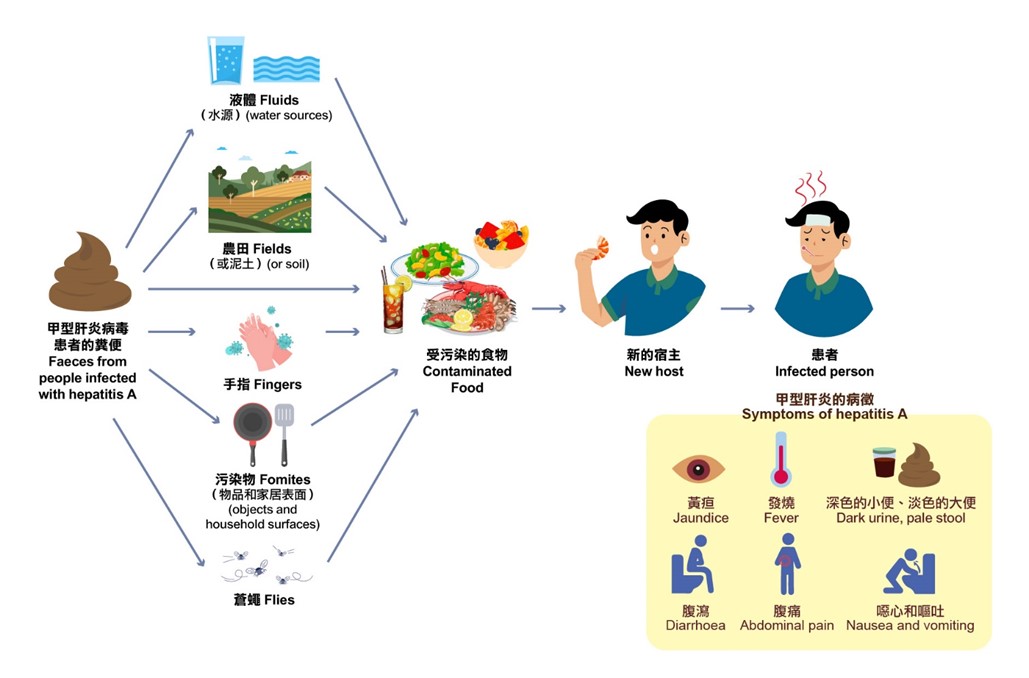
Transmission routes and common symptoms of hepatitis A
Why is HAV Capable of Causing Foodborne Outbreaks Easily?
Why is HAV Capable of Causing Foodborne Outbreaks Easily?
HAV can be transmitted via food efficiently. Furthermore, if an infected food handler does not wash his hands properly after using the washroom, he may spread HAV to the food and the utensils he touches. In some parts of the world where there is inadequate treatment of human waste, HAV from stools may contaminate drinking and irrigation water. This is especially an issue for produce, like berries, that are consumed raw and are too fragile to be cleaned thoroughly. With the export of mass-produced food in bulk worldwide, HAV can spread across different parts of the world.
Berries and other produce may be contaminated with HAV at different stages of production, such as when they are irrigated, processed or washed with contaminated water, or when they are handled by people with hepatitis A but have not washed their hands. Furthermore, as these food products require a lot of water and handling during processing, it is no surprise that outbreaks like these have occurred all over the world, especially in countries with low hepatitis A prevalence.
How to Prevent the Spread of HAV in Food?
Water for irrigation, cleaning and food processing should be clean. Visitors to farms should maintain good hygiene and be provided with adequate hand sanitizer.
All people, especially food handlers, should wash their hands properly after using the washroom, before eating, before preparing food and after touching raw food and unclean objects. To prevent foodborne diseases, always follow the Five Keys to Food Safety : choose (choose safe raw materials); clean (keep hands, utensils and working environment clean); separate (separate raw and cooked food); cook (cook food thoroughly to a more stringent temperature at 90°C for 90 seconds to eliminate HAV); and safe temperature (keep food at safe temperatures).
Food handlers may consider receiving hepatitis A vaccines to prevent infections. Those who are experiencing symptoms of HAV infection should refrain from handling food and seek medical attention immediately.
Mascot ON in Lesson
Excessive Pesticide Residues in Vegetables May Affect Health
Best Way to Wash Vegetables
Pesticides are commonly used chemicals to protect crops against pests and diseases. They are effective in raising crop yields, but their residues may remain in food and pose health risks. Pesticides are widely used in the cultivation of vegetables, which make up an integral part of a healthy diet.
What are the Health Implications of Eating Vegetables with Excessive Pesticide Residues
The adverse effects of pesticide residues depend on the nature of the pesticide, as well as the amount and duration of exposure. Eating food with excessive pesticide residues may cause acute and/or chronic adverse health effects. Symptoms of acute poisoning include vomiting, diarrhoea, abdominal pain, dizziness and numbness. In severe cases, people may even have difficulties in breathing, blurred vision and convulsion. Prolonged excessive intakes of pesticide residues have been shown to cause damage to the nervous system or other organs such as liver and kidneys, and affect foetal development in animals.
In order to protect the health of consumers while facilitating international trade, the Codex Alimentarius Commission (Codex) has established Maximum Residue Limits (MRLs) for individual pesticides in selected food commodities. MRL is the maximum concentration of a pesticide residue to be legally permitted. The primary objective of setting MRLs is to encourage the trade to observe Good Agricultural Practice (GAP) to ensure that only the minimum amount of pesticide is applied to food for meeting pest control needs, thereby protecting the health of consumers.
In the past 10 years, there have been no cases of food poisoning caused by pesticide residues in Hong Kong. As long as pesticide is used in accordance with GAP, the residual level will be low and will not affect health. Moreover, the Hong Kong Total Diet Study conducted earlier by the Centre for Food Safety (CFS) revealed that the dietary exposure of the local population to pesticides was low and well below the respective safety reference values (i.e. Acceptable Daily Intakes). Although the findings of the study show that the local population’s dietary intake of excessive pesticide residues is unlikely, they can still adopt suitable measures to reduce food safety risks.
Which One is More Effective? "Soaking in Water" VS "Washing under Running Water"
Many people wash vegetables by soaking in order to remove dirt and reduce pesticide residues. Some recent media reports cited a study from Taiwan, suggesting that prolonged soaking might allow pesticide residues dissolved in water to seep back into the vegetables. In fact, the study merely points out that washing under running water is more effective than soaking in lowering pesticide residues in vegetables, possibly because moving water can carry away pesticides continuously whereas prolonged soaking, on the contrary, will reduce the removal effect. In addition, soaking will drain nutrients (especially water-soluble vitamins) from vegetables. Therefore, the CFS does not recommend washing vegetables by soaking.
In summary, it is preferable to wash vegetables thoroughly under clean running water before consumption. This is effective in removing surface contaminants, including pesticide residues. Where appropriate, scrub produce with a hard surface by using a clean produce brush to remove dirt, pesticides and contaminants from the surface and the fissures. However, use of soaps, special detergents or produce washes is not advisable so as to avoid additional chemical residues.
Dining Out
Home-packed Meals
Preparing home-packed meals is a common and easy way to enjoy homemade dishes at school or at work. However, these meals may have been stored under unsafe temperatures or transported for some time, making them susceptible to contamination and harmful bacterial growth. If they are not stored properly, pathogens can multiply to dangerous levels or produce toxins, leading to food poisoning.
Certain venues, such as schools, may not provide chilling or reheating equipment. Therefore, when preparing home-packed meals, appropriate measures should be adopted having regard to the setting where the meal is consumed to ensure food safety.
General Advice
During meal preparation and transportation, adhere to the Five Keys to Food Safety and follow the following advice:
- Susceptible populations including the elderly, pregnant women, people with weakened immunity, infants and young children should avoid consuming raw or undercooked foods.
- For people with food allergies, read the ingredient lists on prepackaged food products carefully and watch out for allergens when choosing food ingredients.
- Keep prepared food away from the temperature danger zone (i.e. between 4°C and 60°C), where most pathogens grow and multiply quickly.
Preparation
- Cook food thoroughly until the core temperatures reaching at least 75°C.
- For cooked food requiring chilling, cool it promptly, pack it in a clean insulated container and store it in the refrigerator at 4°C or below within two hours.
- If only a portion of the pre-cooked food of a meal (e.g. dinner of the night before) is used for preparing a home-packed meal, it is preferable to transfer and cool that portion of food in a separate container before the meal is consumed to avoid contamination on the table.
Nitrite in Pre-cooked Vegetables Stored Overnight – Should I Be Concerned?
Vegetables are an essential part of a healthy diet. There have been concerns about the potential health risks associated with consuming pre-cooked vegetables left overnight (e.g. the production of nitrite). The CFS had conducted a risk assessment study on the nitrite levels in cooked vegetables and found that no nitrite was detected in the cooked vegetables stored overnight at refrigerated temperatures (0°C to 4°C), whereas there was an increase in the nitrite level in cooked vegetables left at room temperature. Therefore, for home-packed meals with pre-cooked vegetables, proper storage at safe temperatures is the key to inhibiting bacterial growth and subsequent nitrite formation in cooked vegetables.
Packing, Transportation and Storage
- Pack meals right before leaving home.
- Keep packed meals at a safe temperature when commuting:
Hot foods
- Cooked or reheated food should be kept at or above 60°C in suitable insulated containers.
- Cook or reheat food thoroughly until the core temperatures reaching at least 75°C before packing it into an insulated container.
Tips for Using Insulated Containers
Insulated containers such as insulated bottles and meal boxes help to keep food at a safe temperature. Generally speaking,
- fill the insulated container with boiling water first and drain it after a few minutes;
- transfer thoroughly cooked and piping hot food to the pre-heated container immediately after preparation;
- seal the container tightly and avoid opening it until mealtime to avoid heat loss;
- follow the manufacturer’s instructions for optimum hot-holding effect.
Cold foods
- For cold foods such as chilled pre-cooked meals, ham sandwiches, salads and other cold perishable foods, they should be kept at or below 4°C in an insulated meal box or bag with at least two cold sources (e.g. multiple ice gel packs, or an ice gel pack along with a frozen carton drink or frozen bottle of water) to keep food cold and safe until mealtime. Place the cold sources on top of and underneath the perishable food items inside the insulated bag.
- Upon arrival at the venue, put the cold food into a refrigerator (if available).
- If a refrigerator is not available, avoid packing meals with cold perishable foods.
Below are some examples of shelf-stable foods that you may want to consider for packing meals:
- Biscuits
- Cereal, nuts, cereal bars
- Bakery products (without fillings)
- Whole fruits and dried fruits
- Unopened cans of meat and fish
- UHT-treated beverages
- Make sure all cutleries, containers, utensils and food bags are clean before use.
Consumption
- Once the food has been exposed to room temperature for some time, it should be consumed as soon as possible. Any food that has been left at room temperature for more than four hours should not be refrigerated or consumed, and should be discarded instead.
- If reheating is required, ensure that the food is thoroughly reheated until steaming hot. If a food thermometer is available, check the core temperature of the food to ensure that it has reached at least 75°C before consumption. Do not reheat the food more than once.
- If a microwave oven is used for reheating, stir the food during the process to facilitate even distribution of heat. Cook frozen convenience meals according to the instructions on the package.
- Maintain proper hand hygiene (e.g. washing hands) before eating.
- For leftover food that has been stored in the meal box for too long and has not been kept at a safe temperature, discard it into a covered rubbish bin.
- Clean all reusable cutleries, utensils, containers and food bags with hot soapy water after the meal.
Food safety advice on home-packed meals:

Healthy Eating Basics and Smart Food Choices
Healthy Eating Basics
Targeted Food Surveillance Project on the Nutrition Labelling of Prepackaged Potato Chips and Shrimp Crackers
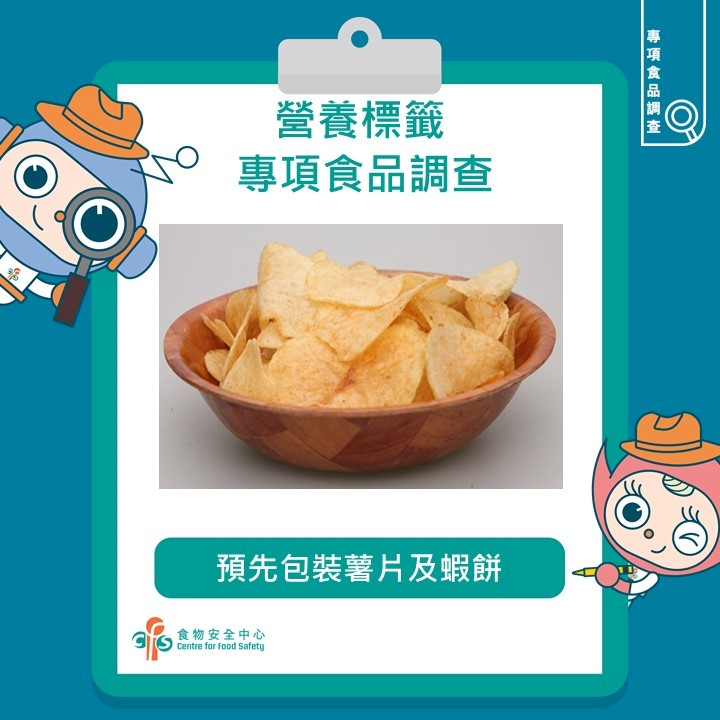
The CFS has recently completed a targeted food surveillance project on the nutrition labelling of prepackaged potato chips and shrimp crackers. Among 40 samples tested, seven samples were found with sugars, sodium, saturated fat, total fat or carbohydrates content inconsistent with the declared values on their nutrition labels, while the remaining 33 samples passed the test.
The CFS collected samples from different retail outlets for the targeted food surveillance project. Tests were conducted to check if the energy content and specified nutrient content are consistent with the declared values on their nutrition labels.
The CFS will continue to conduct surveillance, and the results will be released in due course. The CFS reminds the food trade to comply with the law, and urges members of the public to pay attention to the information on nutrition labels when choosing and purchasing food, maintain a balanced diet and stay healthy.
The CFS has followed up on the unsatisfactory samples. The related press release is available on the following homepage: https://www.cfs.gov.hk/english/press/20230425_10291.html

Smart Food Choices
Baked Fish Fillet in Foil with Angel Hair in Mediterranean Style
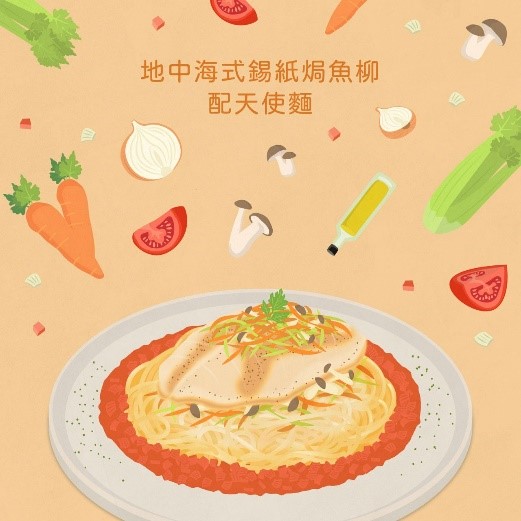
A tasty sauce is essential for cooking yummy pasta. In this issue, we will show you how to make "Baked Fish Fillet in Foil with Angel Hair in Mediterranean Style". The fresh tomato sauce used is lower in fat than creamy or cheese sauce, making the dish not only delicious but also a "3 Low" healthy choice.
Please visit the following website for the Eat Smart Recipe: https://restaurant.eatsmart.gov.hk/eng/content.aspx?content_id=575

News on CFS
1. The 53rd Session of the Codex Committee on Food Additives (2023)
The 53rd Session of the Codex Committee on Food Additives, which took place from 24 to 31 March 2023 at the Regal Airport Hotel, was chaired by China as the host country with the CFS assisting in its organisation. Mr Lei Haichao, Vice Minister of the National Health Commission, was one of the officiating guests, and the event was attended by about 220 representatives from 51 member countries and one member organisation (the European Union) as well as 25 international organisations worldwide. Translation services in four international languages (Chinese, English, French and German) were available, and the session was broadcast live online worldwide.
Moreover, to coincide with the 60th anniversary of the establishment of Codex, celebration events were organised by the CFS specially for the participants from all over the world so that they could learn more about China and Hong Kong despite the busy schedule.


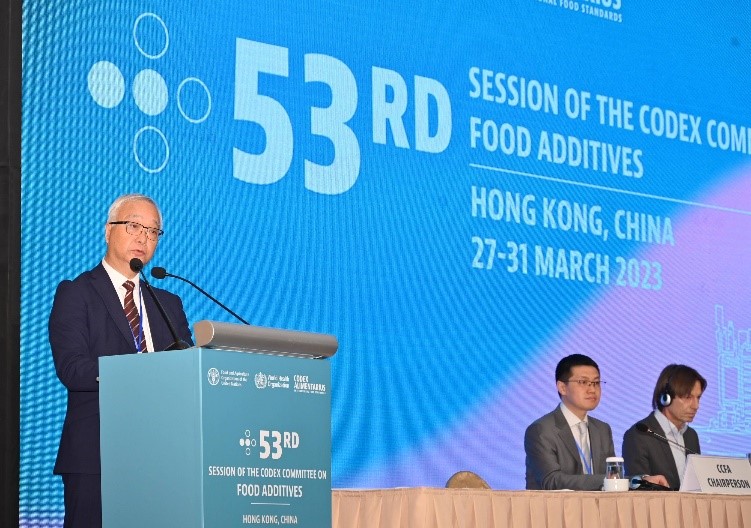
2."Post-COVID-19 Food Safety: Antimicrobial Resistance and Practising Good Hygiene Practices" Webinar Organised by CFS
The CFS implements a routine surveillance programme on antimicrobial resistance (AMR) in raw meat and ready-to-eat food on sale in Hong Kong. In view of the recent surveillance results, the CFS specially urges food businesses to stay vigilant about food safety and follow the Five Keys to Food Safety to prevent the risks of food poisoning and AMR in food. Inappropriate food handling encourages the spread of AMR bacteria, while inadequate knowledge and training among food handlers poses potential threat to food safety. To enhance food safety education, the CFS held four webinars for the trade on "Antimicrobial Resistance and Practising Good Hygiene Practices" starting from mid-April.
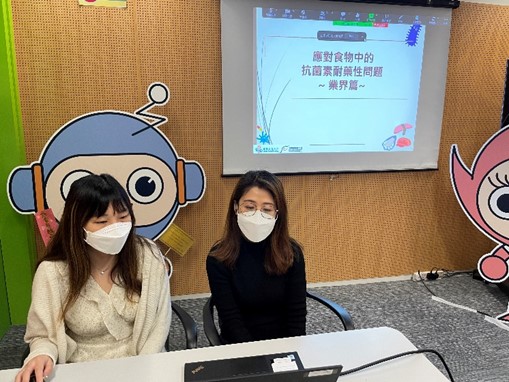
3. The 80th Meeting of the Trade Consultation Forum
The 80th meeting of the Trade Consultation Forum, in physical form, was held on 27 April 2023. The CFS and the trade exchanged their views on topics including "Guidelines on Food Safety and Hygiene for Vending Industry", "How to Address Antimicrobial Resistance (AMR) in Food", "Food Labelling and Nutrition Labelling of Prepackaged Food", "New Arrangement for Extension of Fresh Food Imported via Hong Kong-Zhuhai-Macao Bridge" and "Commencement of Expedited Processing of Import Licence Applications for Frozen Meat and Poultry". For details, please visit:
https://www.cfs.gov.hk/english/committee/Notes_and_Presentation_Materials_TCF80_20230427.html



4. CFS Joined "Tsuen Wan District Weekend Bazaar"
The CFS took part in the "Tsuen Wan District Weekend Bazaar" organised by the Tsuen Wan District Environmental Hygiene Office of the Food and Environmental Hygiene Department at Sha Tsui Road Playground over the three-day long weekend from 26 to 28 May. Video clips on food safety were played from a broadcasting van set up by the CFS in the bazaar. There were also booths set up by other government departments (including the Police and the Fire Services Department) for distributing publicity materials and giving information relating to the departments to the public. Moreover, as well as 60 booths selling a diverse range of commodities, there were various booth games and stage performances, making the bustling bazaar a fun-filled occasion for the public.




5. Public Consultation Forum on Proposed Amendments to Preservatives in Food Regulation (Cap. 132BD)
The Government has launched a public consultation exercise on the proposed amendments to the Preservatives in Food Regulation (Cap 132BD) (the Regulation). It will last for three months until 28 August 2023. To this end, the CFS held the first public consultation forum on 9 June 2023, where the participants enthusiastically shared their opinions and asked questions about the proposed amendments.
Members of the public are welcome to express their views on the proposed amendments during the consultation period. The consultation document is available for download on the CFS's website:
https://www.cfs.gov.hk/english/whatsnew/whatsnew_fstr/whatsnew_fstr_Proposed_Amendments_Preservatives_Food_Regulation.html
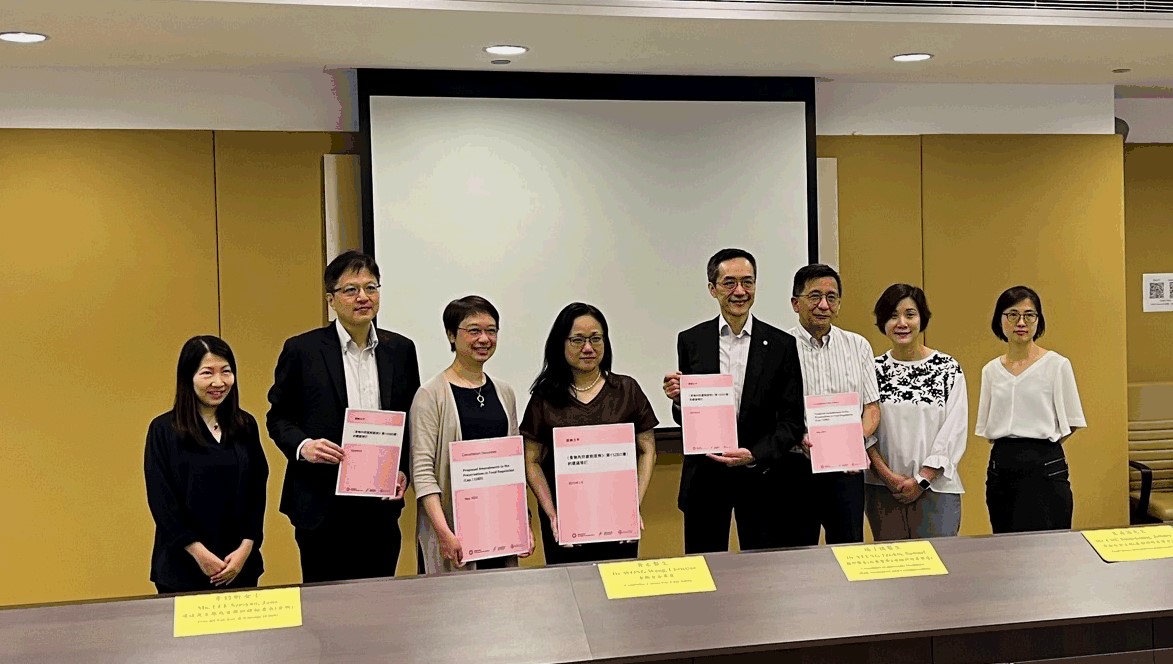

Ask Our Mascots
How to Interpret the Test Report on Goji Berries
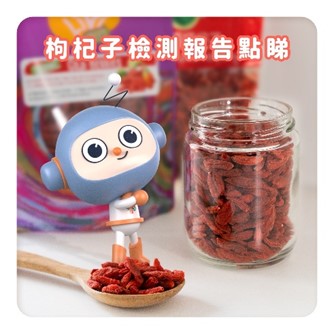
An organisation collected 27 dried goji berry samples on the market for food safety and nutrient content tests. According to the test report, metallic contaminants, pesticide residues, etc. were found in some samples.
Listen To Our Mascots:
- Metal naturally exist in the environment. Despite the traces of metallic contaminants detected in some goji berry samples, all test results complied with the requirements of the local laws, the Codex and the Pharmacopeia of the People's Republic of China.
- For the two products with lead concentration close to the legal limit, the CFS promptly collected samples of the same type of products for laboratory tests. After applying the conversion factor, the test results were satisfactory (0.01 mg/kg of lead in food for one sample and no lead was detected in another sample).
- For the goji berry products with traces of pesticide residues detected, the risk assessment of the CFS revealed that all samples met the legal requirements as they would not be detrimental to health upon normal consumption.
- Taking the two pesticides (i.e. chlorfenapyr and chlorothalonil) mentioned in the test report as examples, the public would have to consume over 29 kg and 16 kg of the relevant goji berry products per day respectively to pose a health risk.
A Reminder On Food Safety:
- consumers should patronise reputable shops and avoid goji berries with abnormally intense colour and sold at an excessively low price.
- choose goji berry products with intact packaging as far as possible because their quality is more stable and they are less prone to be spoiled, attacked by insects, contaminated or dampened.
- dried goji berries should be stored in a clean airtight container and kept in a cool, well-ventilated and dry place.
- soaked goji berries should be used as soon as possible to avoid the growth of bacteria.
Food Safety Quiz
-
Given that bakery products are usually made with ingredients containing partially hydrogenated oils, what is/are the health effect(s) of excessive consumption of such products?
- Loss of weight
- Increased risk of coronary heart disease
- Healthier heart
- Increased bone density
- To avoid purchasing goji berries with excessive metallic contaminants and pesticide residues, members of the public should:
-
Patronise reputable shops
- Avoid goji berries with abnormally intense colour and sold at an excessively low pricE
- Choose goji berry products with intact packaging as far as possible
- All of the above
-
- Which session of the Codex Committee on Food Additives was held in Hong Kong in 2023?
-
53rd
-
55th
-
60th
- 65th
-
Answers:
- b
- d
- a
Diary of Mascot ON
Risky Food Across the Border
Is there any "germ-free dimension" in the world of games? The real world, however, is filled with invisible bacteria that are ready to multiply in food given the right temperature and time.
- High Risky Cross-border food delivery
Recently, there have been reports of cross-border group purchase services for food. Could it be… the K of Hearts? Or the K of Diamonds? Actually, it's NOT OK!!!
- Hard to control the temperature during delivery
Even if hygiene standards are met during the production process, any improper control of temperature during the lengthy delivery process may expose the food to the dangerous temperature zone for an extended period of time, which will give bacteria the opportunity to grow and cause a food safety crisis.
- Keep hot food hot and cold food cold
After preparation, cold food should be kept at 4℃ or below while hot food at temperatures over 60℃. Delivery should be made with a clean insulated device as soon as possible. As a glutton, do you really want to take the risk of food poisoning by using cross-border food delivery services for convenience? No way! It's too dangerous!
